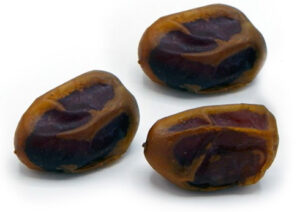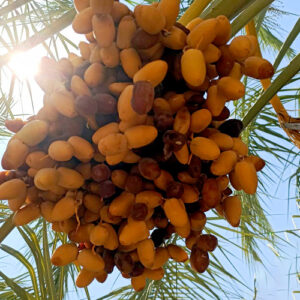Kabkab dates are a type of date fruit that are known for their soft texture, sweet taste, and dark brown color. They are oval-shaped and have a medium to large size, with a thin and slightly wrinkled skin. Kabkab dates have a sweet taste with a caramel-like flavor and are less chewy than other varieties of date fruit, making them easier to eat.
Kabkab dates are a good source of fiber, potassium, and magnesium. They also contain vitamins B and C, iron, and calcium, making them a healthy snack option that can help to boost energy and promote digestive health.
Kabkab dates are a versatile fruit that can be used in a variety of culinary applications. They can be eaten on their own as a snack or used in baking. Kabkab dates can be added to bread, muffins, and cakes, or used to sweeten sauces and dressings. They can also be used in savory dishes, such as tagines and stews.
Kabkab dates can be stored at room temperature for several months. They can also be refrigerated or frozen to extend their shelf life. It is important to store them in an airtight container to prevent them from drying out or becoming moldy.
Overall, Kabkab dates are a delicious and nutritious fruit that can be enjoyed in a variety of ways. Their soft texture, sweet taste, and dark brown color make them a popular snack and baking ingredient.
The Geography of Kabkab Date
The Kabkab date is a type of date fruit that is grown primarily in Iran. The date palm trees that produce Kabkab dates are typically found in the southern regions of the country, where the climate is warm and dry. The date palms require a lot of sunlight and well-drained soil to grow, and they are often irrigated using underground water sources.
Iran is one of the largest producers of dates in the world, and Kabkab dates are one of the most popular varieties of dates grown in the country. They are typically harvested in late summer and early fall, and the fruit is picked by hand and then dried in the sun for several days.
Kabkab dates are also grown in other countries, such as Iraq and Saudi Arabia, but they are not as widely available as they are in Iran. In recent years, there has been an increase in the production of Kabkab dates in other parts of the world, such as the United States and Australia, as growers look to meet the growing demand for this popular fruit.
In summary, Kabkab dates are primarily grown in Iran, where the climate is warm and dry. The date palms require a lot of sunlight and well-drained soil to grow, and they are often irrigated using underground water sources. While Kabkab dates are also grown in other countries, Iran remains the largest producer of this popular variety of date fruit.
Properties of Sayer Dates
Sayer dates, also known as Estamaran or Sair dates, are a type of date fruit that is primarily grown in Iran. They are known for their dark brown color, soft texture, and sweet taste. Here are some properties of Sayer dates:
1. Appearance: Sayer dates are oval-shaped and have a medium to large size. They have a dark brown color and a wrinkled skin. The flesh of the fruit is soft and chewy.
2. Flavor: Sayer dates have a sweet taste with a hint of caramel. They are less chewy than other varieties of date fruit, making them easier to eat.
3. Nutritional value: Sayer dates are a good source of fiber and contain vitamins B and C, iron, and calcium. They also contain natural sugars, making them a healthy snack option that can help to boost energy.
4. Culinary uses: Sayer dates are a versatile fruit that can be used in a variety of culinary applications. They can be eaten on their own as a snack or used in baking. Sayer dates can be added to bread, muffins, and cakes, or used to sweeten sauces and dressings. They can also be used in savory dishes, such as tagines and stews.
5. Storage: Sayer dates can be stored at room temperature for several months. They can also be refrigerated or frozen to extend their shelf life. It is important to store them in an airtight container to prevent them from drying out or becoming moldy.

Overall, Sayer dates are a delicious and nutritious fruit that can be enjoyed in a variety of ways. Their soft texture, sweet taste, and dark brown color make them a popular snack and baking ingredient. They are a healthy snack option that can help to boost energy and promote digestive health.
Harvesting Season of Kabkab Dates
The harvesting season of Kabkab dates typically occurs in late summer and early fall, usually between August and September in Iran. The exact timing of the harvest can vary depending on the climate and weather conditions in the region. The fruit is picked by hand and then dried in the sun for several days before being packaged and sold. Kabkab dates are known for their soft texture, sweet taste, and dark brown color, making them a popular variety of date fruit. During the harvesting season, many workers are employed to pick the dates from the trees and sort them according to size and quality.
Sorting of Kabkab Dates
The sorting of Kabkab dates is a crucial step in the processing of the fruit. Once the dates have been harvested and dried, they are sorted according to size, color, and quality. The sorting process is typically done by hand and requires skilled workers who can identify and separate the dates based on their characteristics.
The first step in sorting Kabkab dates is to remove any debris or foreign matter that may have become mixed in with the fruit during the harvesting and drying process. The dates are then sorted by size, with larger dates being separated from smaller ones. This is important because larger dates are generally considered to be of higher quality and command a higher price in the market.
Next, the dates are sorted by color, with darker dates being separated from lighter ones. This is because darker dates are generally considered to be sweeter and more flavorful than lighter ones.
Finally, the dates are sorted by quality, with any damaged or defective fruit being removed from the batch. This ensures that only the best quality dates are sold to customers.
Overall, the sorting of Kabkab dates is a time-consuming and labor-intensive process, but it is necessary to ensure that the fruit is of the highest quality and meets the expectations of consumers.
Packaging of Kabkab Dates
Packaging of Kabkab dates is an important step in the process of preparing the fruit for distribution and sale. The packaging process involves several steps, including cleaning, weighing, and wrapping the dates in protective packaging.
The first step in the packaging process is to clean the dates to remove any dirt or debris that may have accumulated during the harvesting and sorting process. The dates are then weighed to ensure that they meet the required weight for the packaging.
After the dates have been weighed, they are wrapped in protective packaging, which can include plastic bags, boxes, or other types of containers. The packaging is designed to protect the dates from damage during shipping and to keep them fresh for as long as possible.
In some cases, Kabkab dates may be packaged with other types of dried fruit or nuts to create a variety pack. These packs are often sold as gifts or as a convenient way for consumers to try different types of dried fruits and nuts.
Once the dates have been packaged, they are labeled with the required information, including the date of packaging, the weight, and any other relevant information. The packaged dates are then shipped to distributors and retailers, where they are sold to consumers.
Overall, the packaging of Kabkab dates is an important step in ensuring that the fruit is of high quality and meets the expectations of consumers. Proper packaging helps to protect the dates from damage and helps to keep them fresh for as long as possible.
Transporting of Kabkab Dates
Transporting Kabkab dates requires careful monitoring of temperature and humidity levels to ensure that the fruit remains fresh and does not deteriorate during transport. Dates are sensitive to temperature and humidity changes, and exposure to extreme conditions can cause the fruit to spoil or dry out.
During transport, the dates are typically stored in refrigerated trucks or containers to maintain a consistent temperature. The ideal temperature for transporting Kabkab dates is between 0 and 5 degrees Celsius, which helps to slow down the ripening process and prevent spoilage.
In addition to maintaining a consistent temperature, it is also important to monitor humidity levels during transport. High humidity levels can cause the dates to absorb moisture, which can lead to mold or bacterial growth. On the other hand, low humidity levels can cause the dates to dry out and lose their flavor.
To prevent humidity-related issues, the transport companies may use humidity control measures, such as desiccant bags or moisture-absorbing materials. These measures help to maintain a stable humidity level inside the packaging and prevent moisture from accumulating.
During transport, the dates are also carefully monitored for signs of spoilage or damage. If any issues are detected, the transport company will take immediate action to address the problem and prevent further damage to the fruit.
Overall, transporting Kabkab dates requires careful attention to temperature and humidity levels to ensure that the fruit remains fresh and of high quality for consumers to enjoy. By taking the necessary precautions and monitoring the fruit throughout the transport process, Kabkab dates can be transported safely and efficiently to markets around the world.

